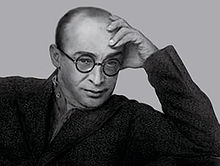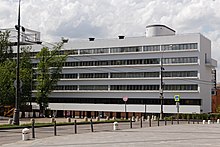| This article includes a list of general references, but it lacks sufficient corresponding inline citations. Please help to improve this article by introducing more precise citations. (May 2013) (Learn how and when to remove this message) |
| Moisei Yakovlevich Ginzburg | |
|---|---|
 Moisei Ginzburg in 1920 Moisei Ginzburg in 1920 | |
| Born | 4 June [O.S. 23 May] 1892 Minsk, Minsk Governorate, Russian Empire |
| Died | 7 January 1946(1946-01-07) (aged 53) Moscow, Russian SFSR, Soviet Union |
| Nationality | Soviet |
| Occupation | Architect |
| Buildings | Narkomfin Building, 1929 |
Moisei Yakovlevich Ginzburg (Belarusian: Майсей Якаўлевіч Гінзбург, Russian: Моисей Яковлевич Гинзбург; 4 June [O.S. 23 May] 1892 – 7 January 1946) was a Soviet constructivist architect, best known for his 1929 Narkomfin Building in Moscow.
Biography
Education
Ginzburg (Ginsberg) was born in Minsk into a Jewish architect's family. He graduated from Milano Academy (1914) and Riga Polytechnical Institute (1917). During Russian Civil War he lived in the Crimea, relocating to Moscow in 1921. There, he joined the faculty of VKhUTEMAS and the Institute of Civil Engineers (which eventually merged with Moscow State Technical University).
Ideologist of Constructivism
The founder of the OSA Group (Organisation of Contemporary Architects), which had links with Vladimir Mayakovsky and Osip Brik's LEF Group, he published the book Style and Epoch in 1924, an influential work of architectural theory with similarities to Le Corbusier's Vers une architecture. It was effectively the manifesto of Constructivist Architecture, a style which combined an interest in advanced technology and engineering with socialist ideals. The OSA experimented with forms of Communal apartments to provide for the new Communist way of life. Its magazine SA (Sovremennaya Arkhitektura, or Contemporary Architecture) featured discussions of city planning and communal living, as well as the futuristic projects of Ivan Leonidov. The group was dissolved in the early 1930s into an 'All-Union Association of Architects', along with the competing Modernist group ASNOVA, led by Nikolai Ladovsky, and the proto-Stalinist VOPRA.
Communal houses



The first of these was the Gosstrakh apartments (Malaya Bronnaya Street, Moscow), designed in 1926, one of which was rented by Sergei Tretyakov: these flats were the first employment of Le Corbusier's 'Five Points of Modern Architecture' in the USSR. A similar structure was built to Ginzburg's 1928 design in Sverdlovsk (21, Malysheva Street, completed 1932).
This was followed three years later by the Narkomfin Building, a 'social condenser' which tried to embody socialist and principles in its structure. The apartment blocks were built for employees of the Commissariat of Finance (or 'Narkomfin'), and featured collective facilities, roof gardens and a parkland setting. The Narkomfin building was acknowledged by Le Corbusier as an influence on his Unité d'Habitation, while the layout of its duplex apartments have been copied by Moshe Safdie in his Expo 67 flats, as well as by Denys Lasdun in his luxury flats at St James', London.
The house has been in a state of disrepair since the 1980s, and has been listed three times in the ‘World's 100 Major Buildings in Danger of Destruction’.
In 1928, Ginzburg also designed the Government Building in Alma-Ata (now, Kazakh National Academy of Arts), completed in 1931. In the early 1930s, he concentrated more on urban planning projects, from utilitarian (Ufa city plan) to utopian ("Green City" contest entry, for a large residential area on the outskirts of Moscow). He was also a Soviet delegate to the CIAM from 1928 to 1932.
Career in 1930s
Like other avant-garde artists with limited practical experience, Ginzburg fell out of favor in 1932, when the state took control of architectural profession and steered it in favor of eclectic, revivalist stalinist architecture. Actual demotion of Ginzburg and other constructivists became a gradual process that extended until the end of the 1930s. He never returned to Moscow or Leningrad practice, but left a contribution in Crimea and Central Asia and retained his own architectural workshop until his death. His new books on Home (Жилище) and Industrializing housing construction (Индустриализация жилищного строительства) were printed in 1934 and 1937; since 1934, Ginzburg was the editor of an encyclopedic History of Architecture.
In the early 1930s, Ginzburg was involved in planning of Crimean Coast, designed a number of resort hotels and sanatoriums; only one of them was built in Kislovodsk (1935-1937). Ginzburg's workshop was also employed by the Ministry of Railways and designed a whole range of model stations for Central Asian and Siberian railroads. Their projects, publicized in the late 1930s, are not as bold as the 1920s avant-garde but are definitely modernist in appearance.
In the 1940s, Ginzburg produced the reconstruction plan for post-war Sevastopol (never materialized) and designed two resort buildings that were completed in Kislovodsk and Oreanda after his death.
Legacy

His most famous work, the Narkomfin Building, having been without maintenance for decades, was on UNESCO's endangered buildings list. Previous proposals to rebuild Dom Narkomfin into a hotel (designed by Ginzburg's grandson) were barred by legal uncertainty over the status of the site. As of 2019, Dom Narkomfin was under careful restoration to become once again a private residential complex. The goal was to restore the building as close to its original state as possible; restoration was completed in 2020.
Dom Narkomfin has suffered greatly from vandalism. Former Moscow mayor Yuri Luzhkov said at the opening of the Novinsky Passage shopping centre: "What a joy that such wonderful shopping centres appear in our city, not like this garbage", pointing to the Narkomfin Building.
Narkomfin has been the subject of Victor Buchli's study of Soviet material culture, Archaeology of Socialism (Berg, 2000), which traces the building's history from early Utopianism to the harshness of the Stalinist era, up to its ruined state in the 1990s.
See also
- Constructivist architecture
- Le Corbusier
- Joseph Karakis
- El Lissitzky
- Konstantin Melnikov
- Hannes Meyer
- Vladimir Tatlin
- Bruno Taut
- Alexander Vesnin
References
- Movilla Vega, Daniel (2020). "Housing and Revolution: From the Dom-Kommuna to the Transitional Type of Experimental House (1926–30)". Architectural Histories. 8 (1). doi:10.5334/ah.264.
- Buchli, Victor (1998). "Moisei Ginzburg's Narkomfin Communal House in Moscow: Contesting the Social and Material World". Journal of the Society of Architectural Historians. 57 (2): 160–181. doi:10.2307/991377. ISSN 0037-9808. JSTOR 991377.
- "The Art Newspaper -- News". 2006-11-28. Archived from the original on 28 November 2006. Retrieved 2024-11-25.
- McKay, Graham (August 2, 2015). "Architecture Misfit #17: Moisei Ginzburg". Misfits' Architecture.
- Cramer, Johannes; Zalivako, Anke, eds. (2013). Das Narkomfin-Kommunehaus in Moskau (1928 – 2012): Dom Narkomfina - das Haus des Volkskommissariates für Finanzen. Berliner Beiträge zur Bauforschung und Denkmalpflege. Petersberg: Imhof. ISBN 978-3-86568-866-8.
- "Narkomfin Building". World Monuments Fund. Retrieved 2024-11-25.
- Wolfe, Ross (2015-07-19). "Moisei Ginzburg's constructivist masterpiece: Narkomfin during the 1930s". The Charnel-House. Retrieved 2024-11-25.
Sources
- Berkovich, Gary. Reclaiming a History. Jewish Architects in Imperial Russia and the USSR. Volume 2. Soviet Avant-garde: 1917–1933. Weimar und Rostock: Grunberg Verlag. 2021. P. 15. ISBN 978-3-933713-63-6
- Ginés Garrido: Moisei Gínzburg. Escritos 1923-1930. Madrid: El Croquis editorial 2007 ISBN 978-84-88386-43-4
- Russian: Ginzburg's railroad designs - И.Г.Явейн, "Проектирование железнодорожных вокзалов", М, 1938
- Historia de la Arquitectura Moderna, Leonardo Benévolo, Editorial Gustavo Gili, S.A., 1996 ISBN 84-252-1641-9
- Ciudad rusa y ciudad soviética, Vieri Quilici, Editorial Gustavo Gili, S.A., 1978 ISBN 84-252-0738-X
- Regional and City Planning in the Soviet Union, H. Blumenfeld, 1942
- La Montaña Mágica, Thomas Mann
External links
- Campaign for the Preservation of the Narkomfin Building
- The Art Newspaper on the Narkomfin
- Photographs of Kislovodsk Sanatorium designed by Ginzburg (with later alterations)
- Russian avant-garde
- Soviet architects
- Constructivist architects
- Modernist architects
- Soviet non-fiction writers
- 20th-century male writers
- Soviet Jews
- Jewish architects
- Russian architects
- Congrès International d'Architecture Moderne members
- Riga Technical University alumni
- Academic staff of Vkhutemas
- Belarusian Jews
- People from Minsk
- 1892 births
- 1946 deaths
- Modernist architecture in Russia
- Soviet male non-fiction writers